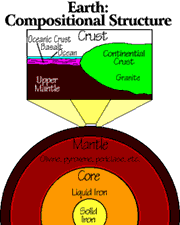

 |
Looking Inside Earth The "skin" of Earth,
called the crust, is very thin like the skin of a peach. It is so thin, in fact, that we
have to magnify a small piece of our sketch of Earth to see any detail at all. There are
two types of crust, oceanic and continental. As you might suspect from the names, oceanic
crust is usually found under the oceans, and continental crust is found on the continents.
Oceanic crust is made primarily of a rock called basalt. It contains almost as much
iron and magnesium as the mantle rock. Oceanic crust also contains thin layers of limestone,
serpentine, and clay. Limestone is made of calcium and carbon dioxide.
Serpentine and clay are rocks like basalt that contain parts of water molecules. An
important fact about these rocks is that when they are heated, the carbon dioxide and
water "boil" out as gases. The "skin" of Earth,
called the crust, is very thin like the skin of a peach. It is so thin, in fact, that we
have to magnify a small piece of our sketch of Earth to see any detail at all. There are
two types of crust, oceanic and continental. As you might suspect from the names, oceanic
crust is usually found under the oceans, and continental crust is found on the continents.
Oceanic crust is made primarily of a rock called basalt. It contains almost as much
iron and magnesium as the mantle rock. Oceanic crust also contains thin layers of limestone,
serpentine, and clay. Limestone is made of calcium and carbon dioxide.
Serpentine and clay are rocks like basalt that contain parts of water molecules. An
important fact about these rocks is that when they are heated, the carbon dioxide and
water "boil" out as gases.Continental crust is made mostly of granite, a rock that contains smaller amounts of iron and larger amounts of quartz. As you may know from just looking around, continental crust also contains some limestone, sandstone, and basalt--a little bit of just about everything. An important fact about continental crust is that it is less dense than basalt or mantle rocks. Thus it "floats" on the mantle rocks like a piece of wood in water. In fact, you and I live on dry land because the continents "float" much higher in the mantle "ocean" than oceanic crust does (just as balsa floats higher than pine). The terms core, mantle, and crust refer to parts of Earth that differ in "composition." Earth's interior is also divided according to "mechanical" behavior. Specifically, parts of Earth bend and flow when pressure is applied, and other parts fracture and break. This way of looking at Earth helps us understand where earthquakes, volcanoes, and mountain ranges are found.
The "asthenosphere" (literally "sphere without strength") is the rest of Earth's interior below the lithosphere. Rock at great depths in Earth slowly bends and flows. (We say the rock is ductile or plastic.) Generally, the rock in the lithosphere has the same composition as the rock in the asthenosphere. So why does it behave differently in different places? The explanation might be called the "Hot Wax Syndrome." If you take a piece of cold wax (like a piece of candle) and squeeze it between your fingers, it will crack and crumble. If you heat wax until it melts, it will flow like water. However, if you heat a piece of wax to almost melting and squeeze the piece between your fingers (careful not to burn yourself!), it will deform and flow like putty. Experiments have shown that nearly all solids (wax, metal, rock, glass) act in the same way: They are brittle at low pressures and temperatures significantly below their melting points, but soft and ductile at high pressures or temperatures near their melting points. So what has this to do with Earth's interior? We have learned through measurements of seismic waves and the flow of heat through the surface of Earth that the interior of Earth is hot. Estimates of the temperatures in the deep interior of Earth range from about 4,000 deg. C to about 7,000 deg. C, which is about as hot as the surface of the sun. (The rock and iron at these temperatures remain as solids and liquids instead of gases because of the very high pressures in Earth's interior.) Yet the surface that you and I stand on is cool and solid. Near the surface of Earth, both temperatures and pressures are low, so rock behaves like cold wax: It cracks and crumbles. As we delve into Earth's depths, temperatures and pressures rise quickly. At a depth of only 50 kilometers (about 30 miles), temperatures are already near 1000 deg. F (500 deg. C) and pressures are near 200,000 psi (pounds per square inch). For comparison, a typical pressure in automobile and bicycle tires is around 35 psi. Putting 200,000 psi inside a tire will blow it to (very tiny) smithereens! Putting 200,000 psi on the outside of a rock heated to near 1000 deg. F will cause it to flow like the hot, but unmelted, wax. So the heat and pressure inside Earth cause rock at depth to be soft, "without strength," forming the asthenosphere.
[ Locations of Volcanoes ] [ Plate
Tectonics & Heat Flow ] [ Home ] [ Teacher Pages ] [ Modules & Activities ] |
|||||||||||||||||||||||||||||
HTML code by Chris Kreger
Maintained by ETE Team
Last updated September 29, 2010
Discuss Exploring the Environment!
Some images © 2004 www.clipart.com.
Privacy Statement and Copyright © 1997-2004 by Wheeling Jesuit University/NASA-supported Classroom of the Future. All rights reserved.
Center for Educational Technologies, Circuit Board/Apple graphic logo, and COTF Classroom of the Future logo are registered trademarks of Wheeling Jesuit University.